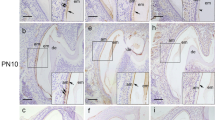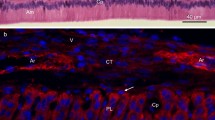Abstract
Enamel proteins can be useful markers for assessment of the functional differentiation of neoplastic epithelium and the nature of extracellular matrices in odontogenic tumors. In the present study, we examined immunohistochemical localization of sheathlin, a recently cloned enamel sheath protein, in various odontogenic tumors to evaluate functional differentiation of tumor cells and the nature of hyalinous or calcified matrices in odontogenic neoplasms. Distinct immunolocalization of sheathlin was observed in the immature enamel of the tooth germ at the late bell stage. Secretory ameloblasts facing the enamel matrix also showed positive staining in their cytoplasm. Definite localization of sheathlin was demonstrated in the enamel matrix in odontogenic tumors with inductive dental hard tissue formation such as ameloblastic fibroodontomas and odontomas. Immunoexpression of sheathlin was, furthermore, demonstrated in eosinophilic droplets in solid nests of adenomatoid odontogenic tumor (AOT) and ghost cells in the epithelial lining of calcifying odontogenic cyst (COC). In AOT, cells facing the eosinophilic droplets also expressed the protein in their cytoplasm. There was neither intracellular staining for sheathlin in the tumor cells nor extracellular staining in the matrix of ameloblastomas and calcifying epithelial odontogenic tumors. Dentin, dysplastic dentin-like hyaline material and cementum in the tumors examined were negative for sheathlin. These results show that immunodetection of sheathlin is a useful marker for functional differentiation of secretory ameloblasts and enamel matrix, which is often hard to differentiate from other hard tissues in odontogenic tumors. Our findings from the view point of sheathlin expression support that the tumor cells of ameloblastomas do not attain full differentiation into functional ameloblasts. It is very interesting that epithelial cells in odontogenic tumors can differentiate into functional ameloblasts without induction by odontogenic mesenchyme, as shown by immunoexpression of sheathlin in eosinophilic droplets within solid epithelial sheets in AOT and ghost cells in the epithelial lining of COC where inductive participation of mesenchymal cells was most unlikely.
Similar content being viewed by others
Author information
Authors and Affiliations
Additional information
Received: 19 May 1999 / Accepted: 27 September 1999
Rights and permissions
About this article
Cite this article
Takata, T., Zhao, M., Uchida, T. et al. Immunohistochemical demonstration of an enamel sheath protein, sheathlin, in odontogenic tumors. Virchows Archiv 436, 324–329 (2000). https://doi.org/10.1007/s004280050454
Issue Date:
DOI: https://doi.org/10.1007/s004280050454




